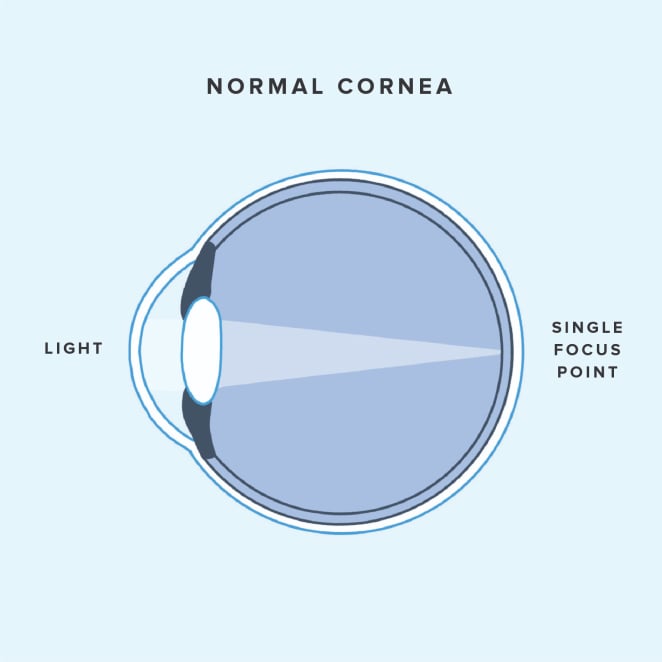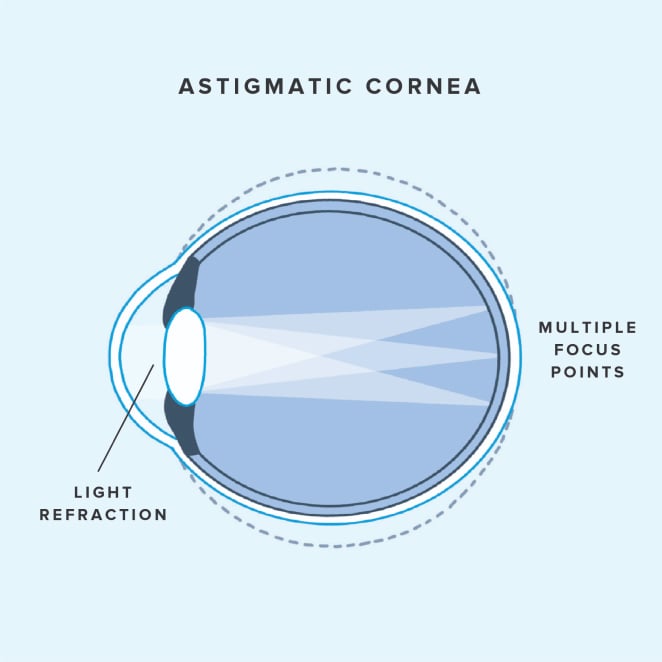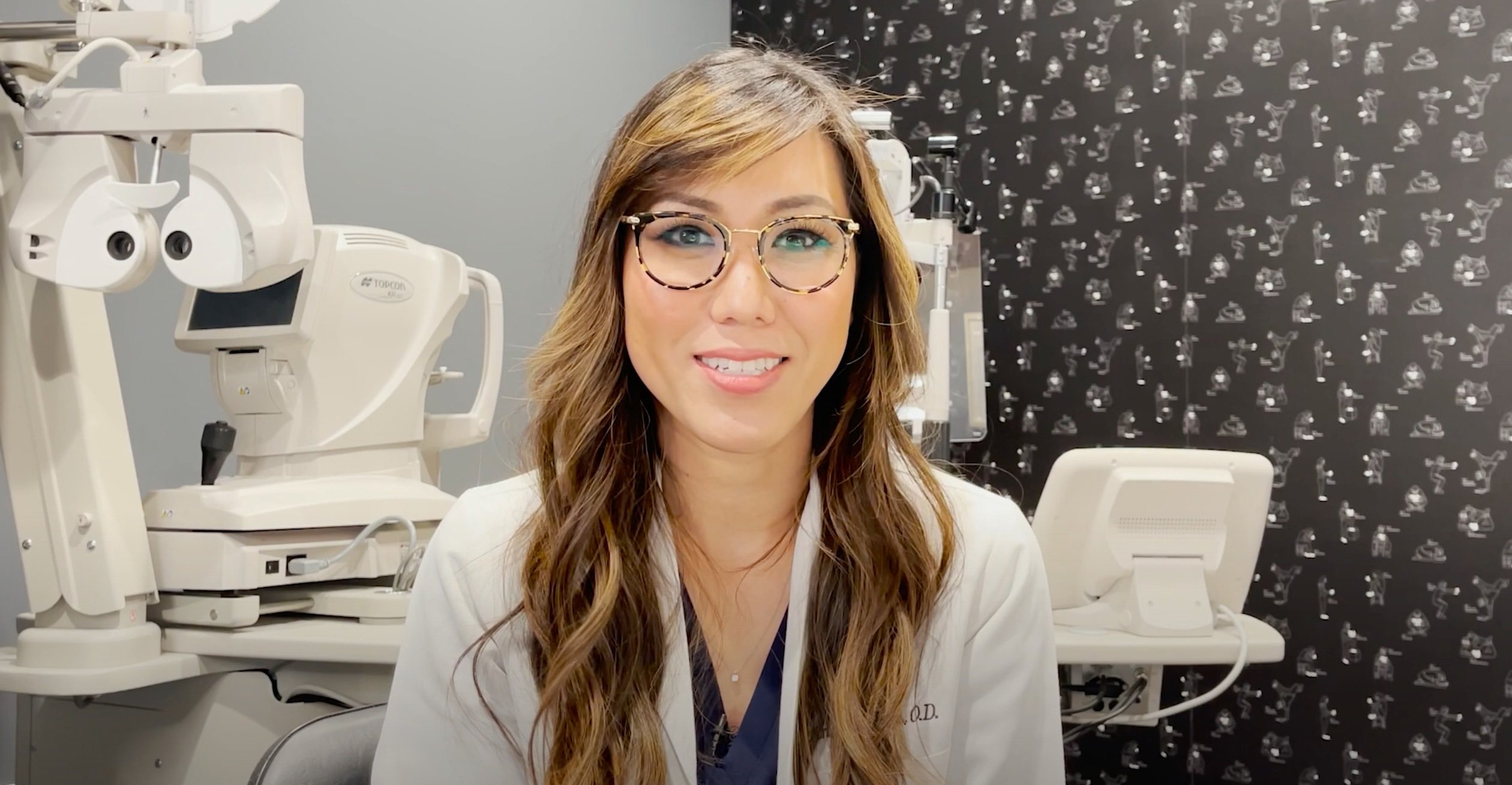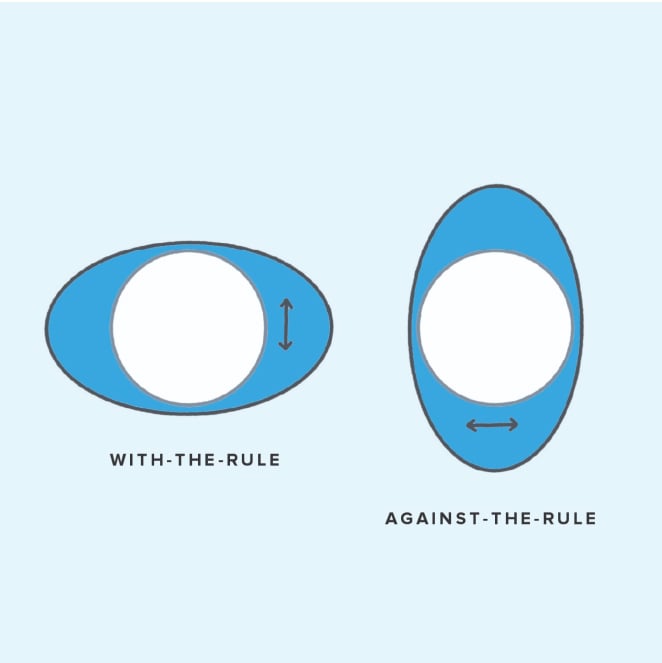Astigmatism is an uneven curvature of the eye’s cornea or lens. It’s a very common eye condition—about one in three Americans have it. Although it can cause inconvenient vision problems, including blurry vision and poor eyesight at night, it’s typically very treatable. Often, all you need is a new pair of glasses or contact lenses.
Read on for more details on the definition of astigmatism, its symptoms, and how eye doctors can diagnose and correct it.
What Does it Mean to Have Astigmatism?
Think of your cornea as a clear, rounded dome over the surface of your eye. In people with astigmatism, that dome isn’t perfectly rounded—it’s shaped more like an egg or a football. The irregular shape of the cornea affects how light is focused inside the eye.
An evenly round cornea (without astigmatism, as seen below) focuses light rays into a single point on the retina at the back of the eye, producing a clear image.
But an unevenly shaped cornea can’t focus light with the same precision. It bends the light so it hits multiple points on the retina instead of just one, resulting in blurred vision at all distances. Here’s how that looks:
Astigmatism, like myopia (nearsightedness) and hyperopia (farsightedness), is a kind of refractive error. Refractive errors occur when the shape of the eye keeps light from focusing properly to a single point on the retina.
Refractive errors are responsible for a host of common vision problems, and they can even coexist: Astigmatism may not be the only refractive error present in a given eye! It’s possible to have astigmatism and nearsightedness, for example.
Types of Astigmatism
Chances are, astigmatism in your eye won’t be exactly the same as astigmatism in another person’s eye—and you can also have different astigmatism corrections in each of your own eyes! Corneas (and lenses) can curve in many different ways. That’s why optometrists sort astigmatisms into types based on the part of the eye they affect and the nature of their shape.
Corneal vs. Lenticular Astigmatism
Astigmatism can affect the cornea or, less commonly, the lens of the eye. People with corneal astigmatism have an irregularly shaped cornea, whereas people with lenticular astigmatism—you guessed it—have an irregularly shaped lens.
Both parts of the eye aid in light refraction, so both types of astigmatism cause similar vision problems.
With-the-Rule vs. Against-the-Rule Astigmatism
Optometrists group astigmatisms into two categories based on their shape: with-the-rule and against-the-rule.
If you have with-the-rule astigmatism, which is the more widespread type, then your cornea has a steeper curve along its vertical axis. Looking at it straight on, it appears to be shaped like a football lying on its side or a sphere that’s been squeezed from the top and bottom.
Against-the-rule astigmatism, on the other hand, refers to a steeper curve along the horizontal axis. Corneas with against-the-rule astigmatism look more like a football standing on its end or a sphere that’s been squeezed from the sides.
Astigmatism Symptoms
How do you know if you have astigmatism? Start by checking for some or all of the following symptoms:
- Blurry vision when looking up close and far away
- A need to squint to discern objects at all distances
- Difficulty seeing clearly in the dark or at night
- Eye strain or eye discomfort
- Headaches
However, having these symptoms doesn’t mean you definitely have astigmatism. The only way to be sure is to schedule an appointment with an eye doctor.
What Causes Astigmatism?
Doctors haven’t yet identified what causes astigmatism, although there does seem to be a genetic component: You’re more likely to have astigmatism if it runs in your family. Most people with astigmatism are born with it, but in others, it develops over time.
Astigmatism can also happen as a result of injury or eye surgery, both of which can change the shape of the cornea or lens.
Contrary to all those warnings your parents gave you growing up, you cannot get astigmatism from sitting too close to the TV screen or trying to read in the dark. (Those habits may give you eye strain, though.)
What Causes Astigmatism to Worsen?
The main culprits are time and aging. In some people, astigmatism may progress slowly and almost imperceptibly, while in others it may get notably more severe as they get older.
Some infants and very young children can “grow out” of astigmatism, but generally it will be a condition you monitor at your annual eye appointments.
How Do You Test for Astigmatism?
Eye doctors can easily test for astigmatism during an eye exam with various tools.
One tool is called a phoropter, and it’s that big assortment of lenses that the doctor will place in front of your face. Optometrists use it to determine what prescription you’ll need to correct any kind of refractive error. They’ll slide different lenses in front of your eyes and ask you which lens gives you clearer vision.
Your doctor may also use an autorefractor. This tool shines a light into your eye and then records how the light changes once it bounces back. Using these measurements, the doctor can determine how “off the mark” the light might be when it focuses inside your eye.
Finally, a keratometer is also useful as part of an astigmatism test. This machine can determine the curve of your cornea simply by gauging a reflection on its surface.
For even more detail, your doctor could use corneal topography, which painlessly scans your cornea and produces a 3D map of its shape and texture.
Can Astigmatism Be Corrected?
Yes, there are multiple ways that astigmatism can be corrected to ensure that you see clearly. Different options for astigmatism treatment are discussed below, but the main takeaway is that astigmatism can be corrected like other refractive errors: with glasses, contacts, or surgery.
Whether you end up with a prescription for glasses or contacts, your astigmatism can be corrected with cylindrical lenses (as opposed to spherical lenses). Cylindrical lenses will properly correct astigmatism by refracting light onto a single point on the retina.
Prescription Glasses
Wearing eyeglasses is one popular way to correct astigmatism. After diagnosing your astigmatism, your doctor can determine your eye prescription and fit lenses into the frames of your choice. If you’re not sure what style of glasses to choose, you can always try frames on at home!
Contacts designed to correct more severe cases of astigmatism may look a bit different from the contacts you’re used to.
Scleral contact lenses are larger lenses with edges that rest on the white of the eye (the sclera). The center of the lens is filled with artificial tears before wear and, when in place, sits above the cornea like a second dome. The liquid within the lens helps to “patch” the irregularities in the cornea and improve vision.
Rigid gas–permeable contact lenses are also known as RGP lenses, gas-permeable lenses, and GP lenses. They’re a mouthful (or an eyeful?), but they’re basically “hard” contact lenses as opposed to soft.
People with astigmatism often find that RGP lenses provide greater clarity of vision than soft lenses. This is because RGP lenses hold a constant shape instead of molding to the eye’s surface. However, they do take a bit more to get used to for new wearers.
Hybrid lenses have a “hard” center bordered by soft edges. They combine the comfort afforded by a softer lens with the power of a hard RGP lens.
Astigmatism can be corrected with soft contacts known as toric lenses. While the above specialty lenses often have to be custom-made, many toric lenses do not and can be quickly ordered online or through your eye doctor. They’re “toric” because they look like a slice taken from a torus, which is a more technical term for a donut shape.
Unlike single-vision contact lenses, toric lenses can have multiple different focal lengths to help address the vision problems caused by astigmatism. Because astigmatism is based on the unique shape of your cornea, toric lenses also typically have a “top” and a “bottom” and shouldn’t rotate any which way on the surface of your eye. They also boast features that help them to stay in place once you’ve put them in.
Orthokeratology
Orthokeratology, often shortened to “ortho-k,” is the practice of wearing specialized RGP contact lenses overnight that gradually change the shape of your cornea. As the lens applies slight pressure and molds your cornea each night, eventually you begin to see clearer during the day.
Ortho-k is most commonly used to counteract the development of myopia (nearsightedness), but it can also aid in correcting astigmatism. The lenses’ effects will diminish if you stop wearing them while you sleep, so this astigmatism treatment requires diligence.
Surgery
People with astigmatism may pursue surgical treatments such as LASIK and PRK, both of which change the shape of the cornea to correct refractive errors.
When someone undergoes cataract surgery that removes their eye’s natural lens, they might also opt to have a toric artificial lens that corrects astigmatism put in its place.
Your Astigmatism Can Be Corrected—Just Talk to Your Eye Doctor
An optometrist or ophthalmologist will be able to tell you whether you have astigmatism and how severe it is. Just remember that if you do end up needing glasses or contacts for astigmatism, you’re in good company.











